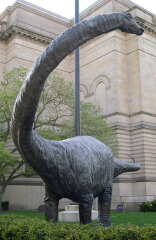Sauropodomorpha
|
|
| Sauropodomorpha | ||||||||||||
|---|---|---|---|---|---|---|---|---|---|---|---|---|
 A statue of Diplodocus carnegiei, outside the Carnegie Museum | ||||||||||||
| Scientific classification | ||||||||||||
| ||||||||||||
| Groups | ||||||||||||
The Sauropodomorpha were a group of long-necked, herbivorous dinosaurs that eventually dropped down on all fours and became the largest animals that ever the walked the earth.
| Contents |
Description
Sauropodomorphs were adapted to browsing high among the trees, and most of their defining characteristics support this feeding strategy. A light, tiny skull on the end of a long neck (with ten or more elongated cervical vertebrae) was balanced by a long tail (with one to three extra sacral vertebrae) when reaching high above the ground.
Their teeth were weak, and shaped like leaves or spoons (lanceolate or spatulate). Their jaws became like scissors in the sauropods, for chopping off vegetation. Instead of grinding teeth, they had stomach stones (gastroliths), similar to the gizzard stones of modern birds and crocodiles, to help digest tough plant fibers. The front of the upper mouth bends down in what may be a beak.
The first known sauropodomorph, Saturnalia, was small and slender (1.5 m, or 5 ft long), but by the end of the Triassic they were the largest dinosaurs of their time, and kept growing. Ultimately the largest sauropods like the Supersaurus, Brachiosaurus, and Argentinosaurus reached 30–40 m (100–130 ft) in length, and 60,000–100,000 kg (65–110 tons) or more in mass.
They were originally bipedal, but as their size increased they quickly came to prefer the quadrupedal position, and rose up on their hind legs only to feed from high tree branches. Some early sauropodomorphs may have been omnivores; it is almost certain that their shared ancestor with the other saurischian lineage, the theropods, was a carnivore.
They also had large nostrils (nares), and retained a thumb (pollux) with a big claw which may have been used for defense — though their primary defensive adaptation was sheer size.
Range
Among the very first dinosaurs to evolve in the late Triassic, about 230 million years ago (Mya), they became the dominant herbivores by the early Jurassic. Their decline in the early Cretaceous corresponded with the spread of flowering plants (angiosperms) and advanced ornithischians, another major group of herbivorous dinosaurs noted for their highly developed chewing mechanisms. Like all non-avian dinosaurs, the sauropodomorphs became extinct 65 Mya during the Cretaceous-Tertiary extinction event.
The most primitive known sauropodomorph is the Saturnalia, which was discovered in 1999, and is dated to the Carnian stage of the late Triassic. Fragmentary remains from Madagascar may represent an even earlier sauropodomorph from the middle Triassic.
Classification
Sauropodomorpha is one of the two major groups (clades) within the order Saurischia. Their sister group, the Theropoda, includes bipedal carnivores like the Velociraptor and the Tyrannosaurus. However the Sauropodomorpha also share a number of characteristics with the Ornithischia, so a small minority of paleontologists like Bakker place both sets of herbivores within Phytodinosauria (or Ornithischiformes).
In Linnaean taxonomy, Sauropodomorpha (which means "lizard feet forms") is either a suborder or is left unranked. It was originally established by Friedrich von Huene in 1932, who broke it into two groups: The primitive Prosauropoda, and their descendants the giant Sauropoda.
The primary evidence that sauropods are descended from the prosauropods is their chronological sequence (stratigraphy). The first known sauropods are from the early Jurassic, long after the first prosauropods appeared, so it appears unlikely that they evolved in parallel. However, the fossil record from the Triassic is scanty and sauropod fossils are relatively rare, so this is not conclusive.
In addition, prosauropods had a smaller outer toe on their hind feet than the sauropods. Since it is far more common for digits to be reduced or lost during evolution than the reverse, this is mild evidence against ancestral prosauropods.
While the sauropodomorphs are still grouped into prosauropods and sauropods for convenience, most modern classification schemes (cladograms) break the prosauropods into a half-dozen groups that evolved separately from one or more common ancestors. While they have a number of shared characteristics, the evolutionary requirements for giraffe-like browsing high in the trees may have caused convergent evolution, where similar traits evolve separately because they faced the same evolutionary pressure, instead of (homologous) traits derived from a shared ancestor.
Since the modern preference is for groups that are composed of all descendants of the same common ancestor (monophyletic clades), instead of groups that exclude certain descendants of that ancestor (paraphyletic clades), Prosauropoda is unpopular except as an informal collection of primitive (basal) sauropodomorphs.
However, some theorists like Benton consider the prosauropods and sauropods to be separate, distinct lineages descended from a common saurischian ancestor. While this is a minority view, supported by weak evidence, there is considerable support for a small, monophyletic Prosauropoda clade containing only a small percentage of its previous members (taxa).
The 1999 discovery of Saturnalia has even raised the possibility that Sauropodomorpha itself is invalid. The dinosaur has the teeth, backbone, pelvis, and legs of a prosauropod, and no unique sauropod characteristics. However, it also lacks a number of characteristics traditionally associated with Sauropodomorpha. Since its ankle is similar to the primitive saurischian/theropod Herrerasaurus, it may be evidence that the sauropodomorphs evolved separately from different saurischian ancestors (polyphyly), and thus are at least two separate taxons. Most remarkably, the joint where the hind limb connects to the pelvis is not entirely open, which is one of the defining characters of all dinosaurs.
This will remain murky until the primitive sauropodomorphs are extensively analyzed using cladistics.
External links
- Sauropodomorpha: Overview (http://www.palaeos.com/Vertebrates/Units/Unit330/330.000.html), from PalŠos.
- Sauropodmorpha (http://users.tamuk.edu/kfjab02/dinos/VPSAUROPOD.htm), from When Dinosaurs Ruled Texas, by Jon A. Baskin.
- Sauropodomorpha (http://personal2.stthomas.edu/jstweet/sauropodomorpha.htm), by Justin Tweet from Thescelosaurus!
- Geol 104 Dinosaurs: A natural history: Sauropodomorpha: Size matters (http://www.geol.umd.edu/~tholtz/G104/10421saur.htm), by Thomas R. Holtz Jr., from the University of Maryland.
- Sauropodomorpha: The prosauropods and the sauropods (http://www.wvup.edu/ecrisp/lec11-sauropodamorpha.html)de:Sauropodomorpha
